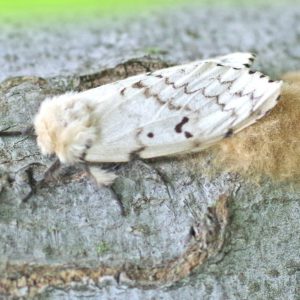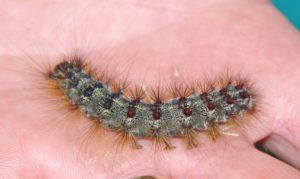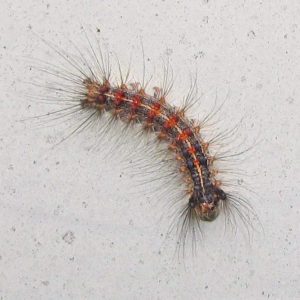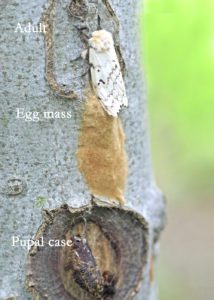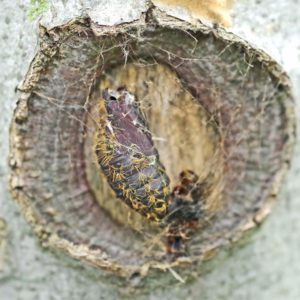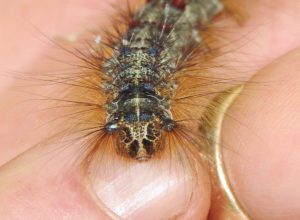Howdy, BugFans,
The BugLady heard from BugFan Joanne recently, from out of state. Her State Department of Agriculture was doing aerial spraying for gypsy moths, and Joanne was having a Silent Spring moment. “Today it seems remarkably bug free around our yard,” she said, “and I am worried.” Here’s a slightly-revised BOTW (some new words and pictures) from ten years ago in which the BugLady did a little sermonizing.
Nota bene – the opinions expressed below belong to the BugLady, who doesn’t have a single bit of vegetation that could be accused of being a horticultural planting. Don’t beat up on the various wonderful organizations that archive BOTW. Also, the BugLady does not like collateral damage.
Grab a snack – this is a long one.
We all know the Gypsy Moth story; it’s the poster child of Invasive Species. Gypsy moths (Lymantria dispar) (Lymantria comes from a Latin word for “destroyer”) were imported from Europe to the Boston area in 1868 by French scientist Leopold Trouvelot. M. Trouvelot planned to do a little genetic tinkering to develop a hybrid gypsy moth/silk moth caterpillar that was hardier than the native silkworms. America’s wild silkworm moths, family Saturniidae, include the spectacular Luna, Cecropia, Polyphemus, and Promethea moths (https://uwm.edu/field-station/giant-silk-moths-family-saturnidae/) along with some lesser-known, smaller species. Their cocoons are rarely unraveled for their silk. Our silkworms are not related to the domestic silk moth (Bombyx mori) in the family Bombycidae, and they’re not related to gypsy moths (family Erebidae) either.
Anyway, some of his breeding stock (inevitably) escaped. The first recorded outbreak was in 1889, and gypsy moths now occupy a wedge of the US from New England to the Carolinas to Minnesota (to see a nifty, animated map that only goes to 2007, check out (http://en.wikipedia.org/wiki/Gypsy_moth_in_the_United_States). They are considered to occupy about 1/3 of the area they could potentially expand into, and in the past 150 years they have stripped gazillions of leaves from billions of trees in the territory they do occupy. Gypsy moth caterpillars feed at night on some 500 kinds of plants, and they are considered a major pest of hardwood (deciduous) trees. Adults are short-lived and do not feed.
Caterpillars are bristly (some people suffer skin irritations from contact), with two bulbous tufts of hairs in front, and two more aft. Gypsy moth larvae get around pretty well – newly-hatched caterpillars use silk to balloon to greener pastures. Caterpillars feed for six weeks, generally in the treetops. The youngest (black) caterpillars chew holes in the middles of leaves, and when they are slightly older they eat the leaf from its edge toward its center. “Teen-age” caterpillars – more colorful, with paired red and blue spots – climb down to the ground to take shelter during daylight hours, returning to the treetops at dusk (during a heavy infestation, they may feed during the day, too). If/when they have defoliated a tree, they hike overland, en masse, to find another.
Males grow through five instars (an instar is the eating phase between two molting phases) and females have six instars before they look for a place to pupate (which may be on a tree, a porch, a stack of firewood, a travel trailer, etc.). After pupating for two weeks, males emerge before the females so they are lined up when the females emerge, and the wild rumpus begins. Adult females are flightless and are stuck wherever they pupated – they use pheromones to lure flying males to their perch, and then create an egg case on the same spot.
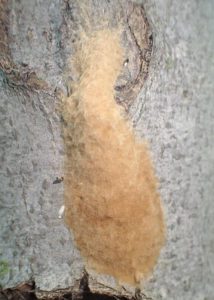
What’s all the fuss about? It’s estimated that gypsy moths defoliate more than a million acres of forest a year – sometimes significantly more – and they consider trees on suburban lawns to be as tasty as those in the woods. And then there’s the “Ick Factor.” During a large infestation, roads, patio furniture, and outside walls are thick with the sights and sounds of caterpillars crawling and munching and of frass (caterpillar poop) raining down.
Tell us, BugLady, after 150 years of noshing, are there any trees left in the eastern US at all? Why yes, Dearies, there are. Ever driven the Mass Turnpike (which is close to gypsy moth Ground Zero)? There are huge forests of large trees, miles and miles of trees (though forest composition may have changed some). For many trees, the defoliation is only a temporary nuisance. A tree’s potential for recovery is based on what percent of its leaves are eaten, on its species and health, on the amount of soil moisture, and on whether this is defoliation number one, two, three, or more. Most healthy trees will survive a couple of consecutive years of 50%-plus defoliations, re-foliating by mid-summer (although re-foliating saps their energy reserves). Stressed or compromised trees may be killed by the next outbreak.
When caterpillar numbers are low (not every year is a BIG year), birds, shrews, mice (there’s a fascinating connection between levels of acorn production, mouse populations, and gypsy moth infestations), chipmunks, raccoons, wasps, ants, flies, fiery searcher beetles https://bugguide.net/node/view/535769, and weather (very cold winters and roller-coaster springs) are effective caterpillar controls. In outbreak years, flocks of blackbirds and several bacteria, fungi, and viruses have joined the fray.
To these, we have added imported tachinid flies (of previous BOTW fame), whose maggots parasitize the caterpillars. Tachinid flies that were imported to eat the imported gypsy moths, however, have acquired a taste for native caterpillars, especially caterpillars of our large silk moths, whose numbers have dipped. We also wage chemical/biological warfare on them, in the form of the bacterial pesticide, Bacillus thuringiensis (Bt), and with chemical pesticides – contact poisons that affect a larva’s digestive tract (and that may damage humans, too). In some parts of Britain, test areas were “flooded” with pheromones to overwhelm the male gypsy moths’ senses and keep them from finding females.
The $64,000 question is “Should something be done about gypsy moths? The answer seems to depend on whether people see a lot of caterpillars on the landscape or only a few. Eric R. Eaton and Kenn Kaufman, in the Field Guide to Insects of North America state that “Probably more damage has been done by the huge amounts of poisons sprayed on forests in ill-conceived attempts to control the moth.” Most control methods are not specific to gypsy moth larvae (to repeat – MOST CONTROL METHODS ARE NOT SPECIFIC TO GYPSY MOTHS), and the blanket elimination of generations of larvae (collateral damage) affects the predators of the larvae and the predators’ predators and a whole lot of innocent bystanders. The ripples move out, and maybe some ripples fetch up on the shores of insect-impoverished landscapes and barren July 4th Butterfly Counts (seems you can’t be a butterfly without being a caterpillar/larva first). And yet people who go to municipal meetings to question community spray policies are accused of being “anti-tree.”
BugFan Naomi shared this personal experience: “I am out for the week in the Driftless area of Wisconsin, where my family has owned a piece of land for 40 years. Our land is a lovely piece of oak savanna but there has been this horrible “bloom” of gypsy moth caterpillars. The trunks of the trees are positively hairy with them, an alarming concentration that is hard to fathom. Just when one could despair that all was lost, we noticed that they were dying on the trunks, head down. They explode into a goo when touched. This turns out to be the work of some fungus they have ingested that is killing them. So although as youngsters they are doing some damage on the lower branches, they are meeting their demise before going to the next stage. Now the trunks are covered with hairy ‘skeletons’ (what do you call the furry, leggy remains of a caterpillar?).”
“Empties,” Naomi, they’re called empties, and one of two agents is at work. One is a Nucleopolyhedrovirus (NPV), a naturally occurring, gypsy-moth-specific virus which causes a “wilt disease” that leaves the critters hanging from tree bark (and which is now used by the US Forest Service under the name of “Gypchek”). The other is a gypsy moth-specific fungus called Entomophaga maimaiga (EM). According to the Midwest Biological Control News, EM, a native of Japan (which has its own gypsy moths), was released near Boston in 1910 in an attempt to control outbreaks. Subsequent tests failed to detect residual fungus in the environment, so the experiment was halted. In 1989, analyses of bunches of mysteriously-dead gypsy moth larvae in the Northeast revealed that their deaths had been caused by EM, but where it had been for 65 years is a mystery.
Trees themselves may have a solution. Bill Bryson, in A Walk in the Woods, offers this story (whose “science” the BugLady verified with her plant guy). Oak trees that are heavily infested with caterpillars emit a chemical (distress) signal that travels to trees downwind. As a result, the downwind populations of trees produce higher levels of tannins, chemicals that make the leaves unpalatable. To this the BugLady says “Wow!” When the BugLady was taking science (and dinosaurs roamed the earth) a list of plant attributes did NOT include the ability to send/receive/process/react to this sort of external stimulus.
Kate Redmond, The BugLady
Bug of the Week archives:
http://uwm.edu/field-station/category/bug-of-the-week/

